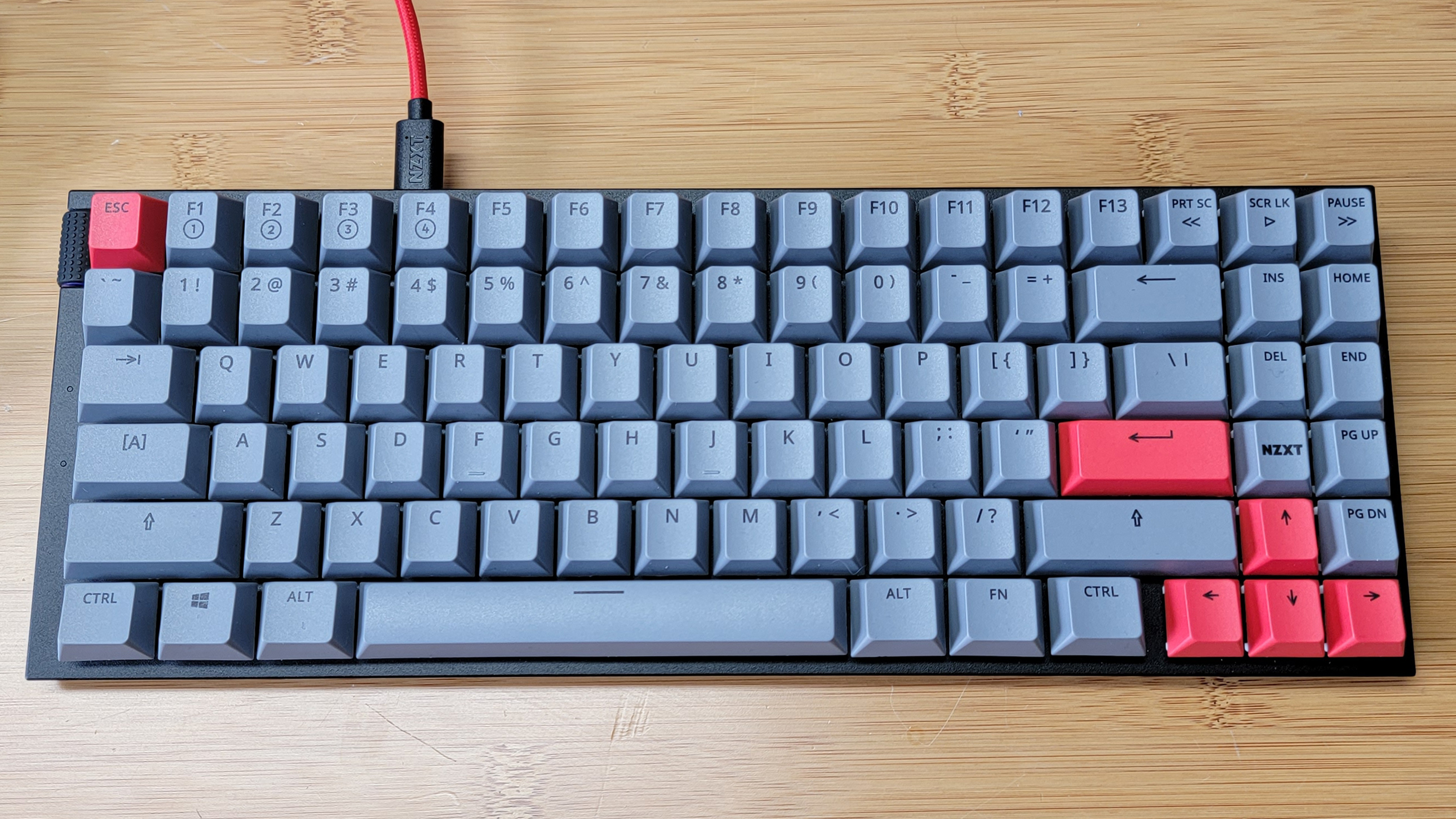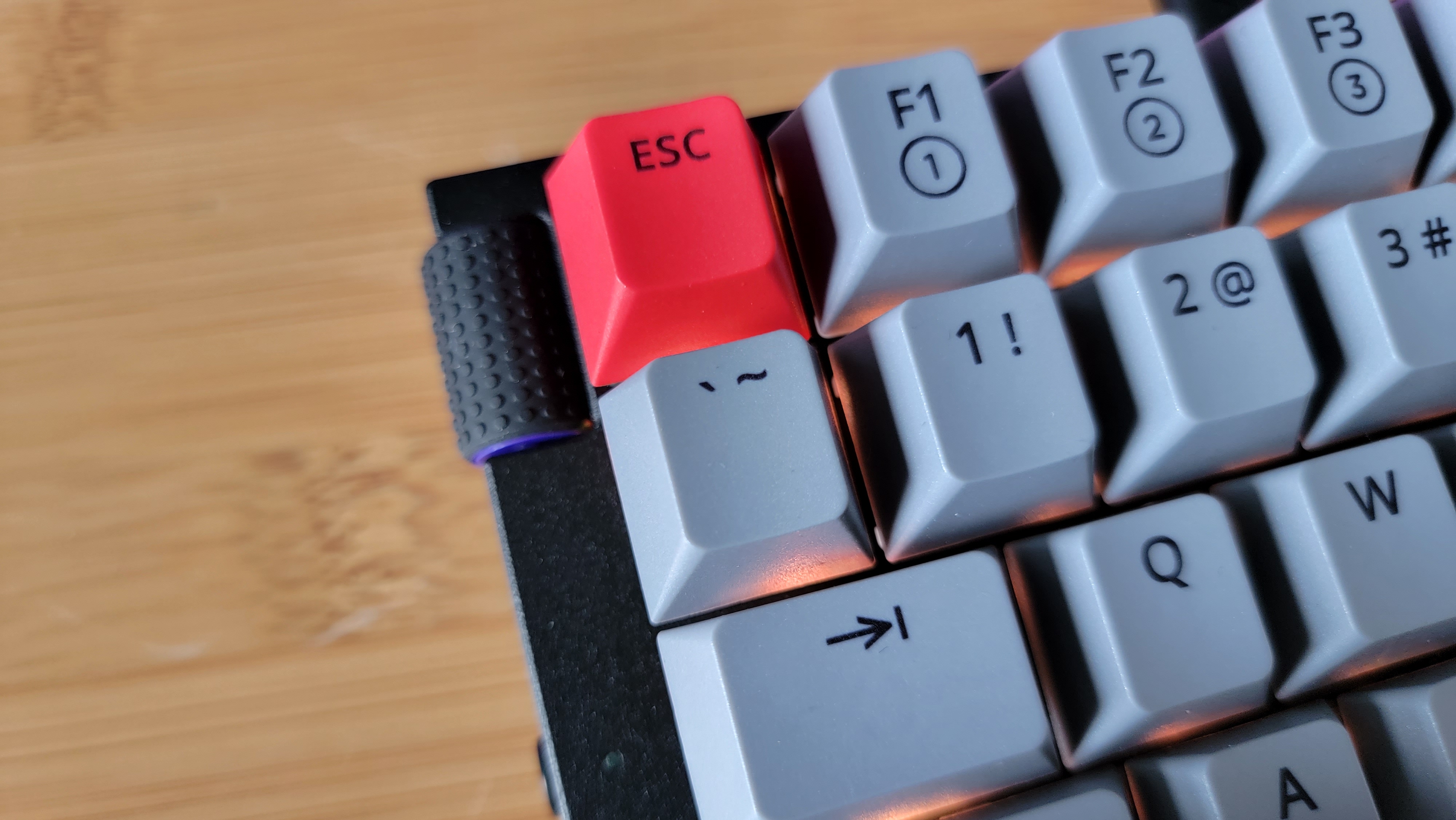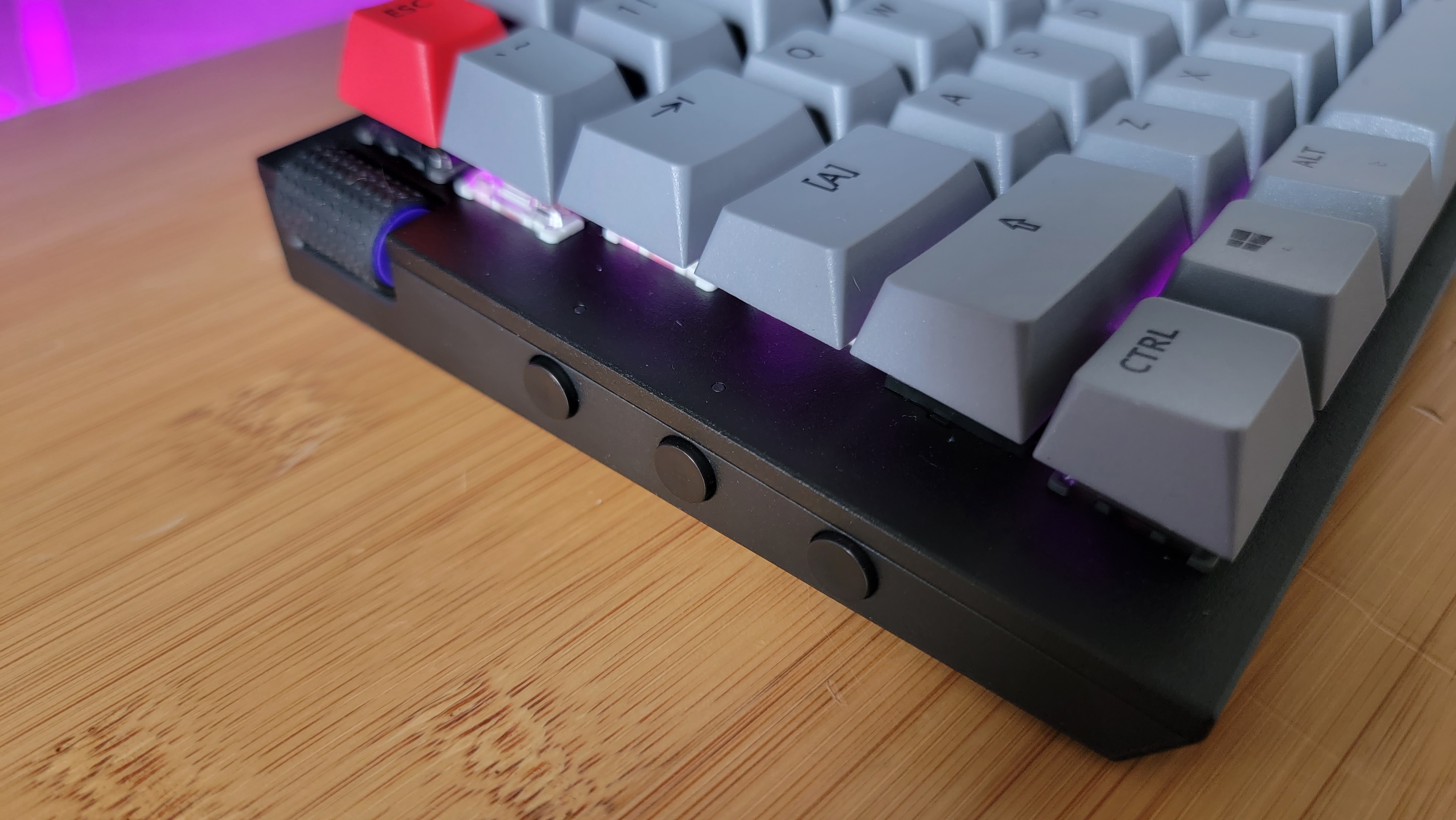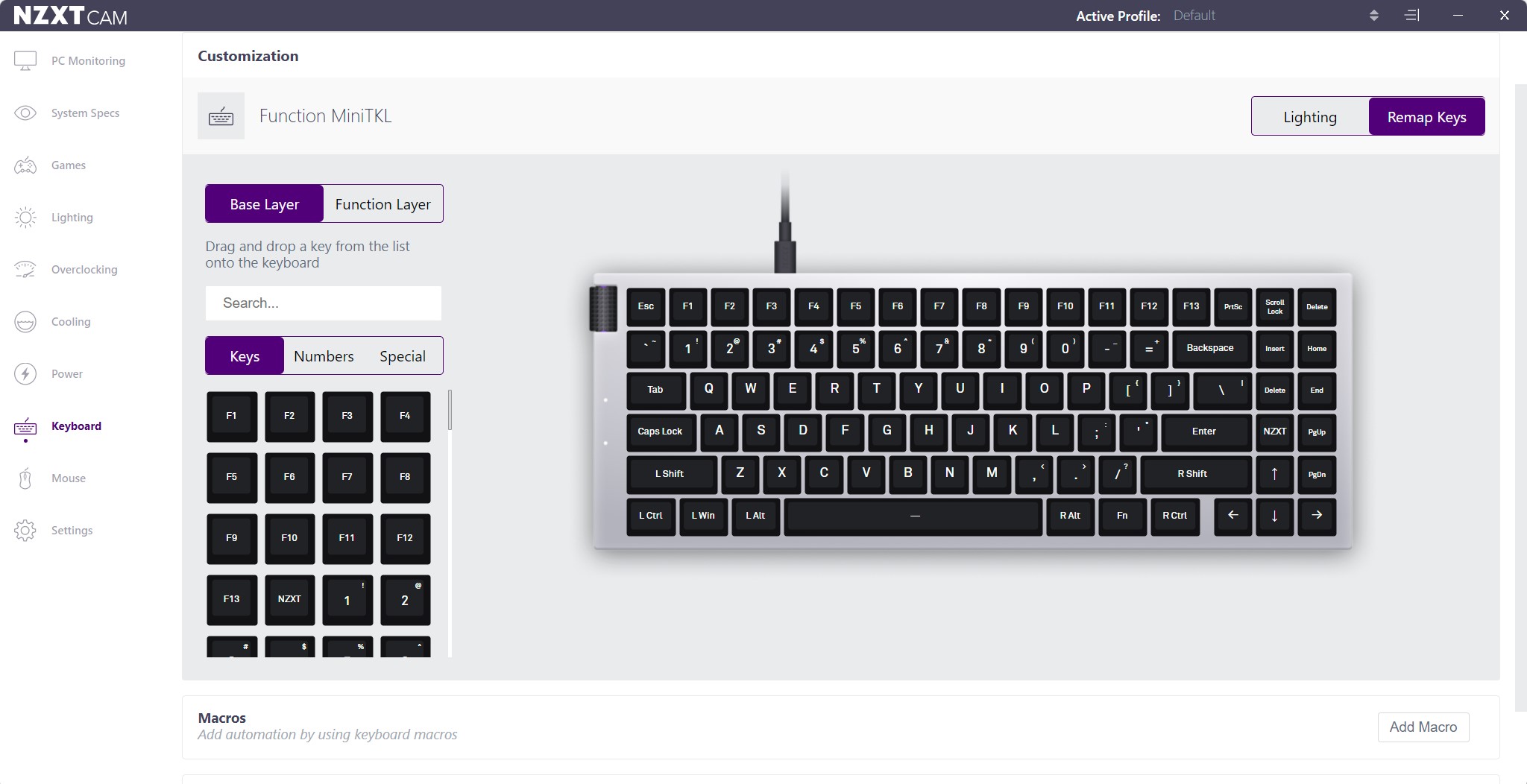Tom's Hardware Verdict
NZXT's Function mechanical keyboards bring hot-swappable switches to the mainstream market in three sizes with plenty of customization options. The Function MiniTKL model delivers an extra column of keys while being just slightly larger than a 75% model. But if you aren't interested in swapping in other switches, there are better options available for less money.
Pros
- +
+ Hot-swappable switches across the lineup
- +
+ Low-profile body feels solid
- +
+ Removable USB-C cable
- +
+ Available in three sizes and colors
- +
+ Unique left-mounted volume roller
Cons
- -
Default ABS keycaps feel generic
- -
Custom model gets expensive fast
- -
MiniTKL version lacks wrist rest
- -
Software has limited keyboard options
Why you can trust Tom's Hardware
NZXT has been expanding beyond cases and cooling for a few years now, releasing a handful of motherboards and microphones. But with its move into keyboards, the company seems a bit more bold and confident. The NZXT Function line launched in three sizes: 100%, TKL and a slightly smaller MiniTKL version that saves space by bunching all the keys up against each other. They're offered in black or white options similar to NZXT's motherboards, and there's a surprising amount of customizability for a mainstream mechanical keyboard line. It's clear the company is aiming for a spot on our best gaming keyboards list.
Retail models will ship with linear Gateron Red switches. But if you order direct from NZXT you can choose between five different switches, five accent keycaps and removable cable colors (so you can match or mismatch as you like), and two shades of dye-sublimated PBT keycaps (the retail models ship with glossy ABS caps). But perhaps most impressively, all of the Function keyboards feature swappable switches so that you can easily change up the feel of the keyboard later on by buying and popping in something new. The keyboards include key and switch pullers that make this process easy.
In a unique design decision, there's a rubberized volume roller mounted on the upper-left corner to make it easier to adjust audio without moving your hands off your mouse. While its placement is novel and took a bit to get used to, I didn't mind the roller on the left, where you'll also find a few small buttons for mute, Windows key locking, and backlight brightness.
But apart from the swappable switch sockets (which are still fairly uncommon in the mainstream gaming keyboard space), the Function keyboards offer little to help them stand out in a very crowded market. If you like the way they look and you want to dip your toe into the custom keyboard world by trying out some different switches, any of the NZXT Function keyboards are worth considering. But if you aren't going to swap switches, there are better options that cost less.
NZXT Function Specs
| Model | MiniTKL | TKL | Full Size |
|---|---|---|---|
| Lighting | Addressable RGB | Addressable RGB | Addressable RGB |
| Onboard Storage | None | None | None |
| Media Keys | Via Fn | Via Fn | Via Fn |
| Connectivity | USB-C to USB-A | USB-C to USB-A | USB-C to USB-A |
| Cable | 20 inches (2 meters) | 20 inches (2 meters) | 20 inches (2 meters) |
| Additional Ports | None | None | None |
| Keycaps | PBT or ABS | ABS | ABS |
| Software | NZXT CAM | NZXT CAM | NZXT CAM |
| Dimensions (LxWxH) | 13.33x4.86x1.59 inches | 14.24x5.03x1.59 inches | 17.4x5.03x1.59 inches |
| Weight | 1.58 pounds | 1.7 pounds | 2 pounds |
Models and Customization Options for the NZXT Function
NZXT sells the Function keyboard in three sizes, and the company seemingly got some pushback after the initial launch that has caused it to revisit pricing. As of this writing, the Mini TKL version was $99.99 on Amazon, while the TKL and full-size model were both $129.99. That makes the MiniTKL I'll be focusing on in this review arguably the most appealing, but note that it lacks a wrist rest, while the larger models have a rubberized magnetic wrist rest that's nice, but a bit narrow.
Another wrinkle to keep in mind is that those prices are for the standard retail versions of the keyboards, which come in black or white, with black ABS shine-through keycaps. The company also lets you customize versions of the Function keyboards on its own site, letting you choose from Gateron Red, Blue or Brown switches for $20 (or Gateron Aliaz Silent or Blacks for $60-$80 more). With the custom option, you also get the choice of a gray metal top plate in addition to the black or white of the retail models. You can also pick black or gray keycaps ($50) which are a nicer PBT plastic but lack the shine-through legends. And because the RGB backlighting here isn't all that bright to begin with, the PBT keycaps really dull the backlight glow.
Other options when going the customization route through NZXT include six accent keycaps ($20) and a USB-C/USB-A cable ($20) in your choice of five colors other than the basic black. All these customization options make you feel like you're getting something tailored to your tastes. But it also basically doubles the price over the $99 retail model. The model NZXT sent my way with a black plate, gray caps, brown switches and red accent caps and a cable lands at $190. If I wanted NZXT to put it all together for me (which I wouldn't because it was easy and fun to do myself) that would add another $10 to the price.
As much as I like the look of the keycaps, extra keys and the red cable, I definitely don't like them $100 more than the $100 base model. Even though the keycaps on the retail models are slick, shiny and pick up fingerprints seemingly faster than my fingers can type.
Design of the NZXT Function
Regardless of which model of the Function you opt for, you get the same pleasingly rubberized volume rocker that lives in the upper-left corner of the keyboard, off the edge of the escape key. NZXT says this placement is optimized for gamers, presumably because you don't have to take your hand off your mouse to use it. But you still need to move your hand away from the WASD and/or number keys (depending on which kind of game you're playing). So I'm not sure how much better this actually is for gamers, though I found myself liking the placement here well enough after a couple days of adjustment.
Get Tom's Hardware's best news and in-depth reviews, straight to your inbox.
Below the wheel, along the left edge of the keyboard, are three round buttons that, from bottom to top, adjust backlight brightness (four levels, plus off), lock the Windows key and mute your audio. Again, I'm not sure if this is any better or worse than placing these buttons elsewhere on the keyboard. But with the MiniTKL model I tested, there is no available space around any of the keys to add extra buttons or lights.
In fact, the MiniTKL version has the keys so close to one another that there's no room even for an LED to indicate Caps Lock. It would be nice if NZXT had, say, made the caps lock switch's LED turn when it was enabled, but as it stands your only indication that caps lock is on is when your keyboard makes it seem like you're shouting everything that you type..
In terms of build quality, all of the models feel good, though not quite great. The top plate is metal, which makes for a solid feel, but the rest of the housing is plastic. The bottom has four rubber slip-resistant pads to keep the keyboard from sliding around, and there are flip-up feet at the back that are made of sturdy plastic and feature two levels of lift. One of the more annoying things about the feel of the keyboard out of the box is the feel of the stabilizers on the larger keys (space, enter, shift, etc.). They're noisy, don't feel great, and are in desperate need of a bit of lubing. This won't bother everyone, but for those who've used high-end custom keyboards, or who are sensitive to keyboard sound, you'll definitely feel and hear it.
Except for the USB-C port for the removable 80-inch braided cable, that's it for external features. There are no pass-through USB or audio ports. And while you can control media with the keyboard, that's done through secondary function keys in the upper right that do double duty as print screen, scroll lock and pause.
Sweet Hot-Swappable Switches
With the main exterior features of the Function keyboards out of the way, it's time to dig below the surface to one of the lineup's stand-out features: its swappable switches. There are some mainstream and/or gaming mechanical keyboards that have swappable switches, like Logitech's G Pro X. And there are dozens of more niche custom keyboard kits that let you swap switches. But this feature is still fairly rare in mainstream, gaming-focused keyboards, and I applaud the fact that NZXT has included swappable switches across its current keyboard lineup. The company even includes both keycap and key pullers in the box to make the process as easy as possible.
As noted, I chose Gateron Brown switches with the custom MiniTKL keyboard. And they're perfectly fine as browns go: tactile, quiet, and kinda boring. But I ordered Holy Panda X switches from Drop a month or so before NZXT's keyboards arrived, and they happened to show up in my mailbox the day after I started testing the Function keyboards. So of course I pulled out the browns and dropped in the new switches.
The process of swapping the switches was straightforward and took about half an hour, first pulling the keycaps (which mount surprisingly tightly on the standard Cherry-style stems) and then pulling the switches by grabbing the tabs at the top and bottom of each switch with the supplied puller. Popping in the new switches (yellow stemmed in the image above) was super simple, requiring just that the pins were oriented at the bottom and that you press them in from above rather than at an angle. The hardest bit by far was putting the keycaps back on correctly when I was done.
While this isn't a review of the Holy Panda X switches, I like them much better than boring browns (they have more resistance and a much springier return, making them feel and sound more satisfying). I also like the idea that, should I buy other switches in the future, I could have a keyboard that's drastically different in less than an hour.
Gaming and Typing Experience on the NZXT Function
My experience using the Function MiniTKL keyboard was mixed, but mostly positive. There are slight quirks with the layout, some of which are more odd than annoying. The right shift key, for instance, is larger than the left one, taking up the space of three regular-sized keys. This bothered me more visually than anything. But the delete key being one column in and three keys down from the top corner annoyed me when writing or editing. That's in part because my daily driver is the Keychron K2, where delete lives in the top row. I used the company's CAM software (more on that shortly) to remap the pause key in the upper-right corner to function as delete to mitigate this issue. But after a couple days, I started getting used to the location of the actual delete key. Since that was my primary frustration, I'm sure I'd be fine with the MiniTKL's layout if I were using this keyboard for work or gaming long-term.
I also put the Function through several hours of gaming, with RTS titles like Stronghold 3 and They Are Billions, as well as the punishing RPG Elden Ring. The brown switches might not be to everyone's gaming taste, but since I am not a competitive esports player, I actually prefer their tactility–although I still like the Holy Panda Xs I swapped into the keyboard better.
The volume rocker on the left edge is supposedly designed to be easier for gamers to use since you don't need to move your hand off the mouse. But I generally adjust the volume to a good level before I start gaming, so I can't say that its placement here was particularly better than having the roller on the right. But I didn't mind its placement here.
Since there is no dedicated bank of macro keys or other gaming-specific features, there wasn't a whole lot that stood out, good or bad, about the Function keyboard when it came to gaming. It's solid, generally feels good, and the MiniTKL model doesn't take up much space on your desk. And while there aren't any gaming-specific keys, the layout does include a few keys you could easily map to macros or other functions, like the odd F13 key and the NZXT key, neither of which do anything out of the box. You'll need the company's CAM software to program those keys, which happens to be the subject of the next section.
Software for the NZXT Function
NZXT's CAM software, much like Corsair's iCue or Asus' Armoury Crate, is designed to do a lot–including monitoring your system's temps and performance and power settings, handle overclocking and even launch games. But its functions when it comes to keyboards is a bit limited and feels clunky.
First off on the lighting side, things are about what you'd expect on the surface. You can choose between six presets for color modes, different multi-color options for those color modes, and choose the number of colors the lighting shifts between, as well as the speed and brightness. There is also a Reactive layer that works atop the base layer, letting you configure how the keyboard reacts when keys are pressed, sending say a line or a ripple across the surrounding keys.
Then there's the remapping section, which looks promising but is oddly designed and doesn't let you do as much as you might want to. You remap keys by choosing the action you want to map a key to by first scrolling or searching the list on the left and dragging that button onto the key you want to map to on the keyboard on the right. This works, but feels counterintuitive. It would feel more natural to click a key on the on-screen keyboard, then press the key you want to program that to on the actual keyboard, then click save. The way CAM has this setup feels backwards, though it does work.
While there are definitely keys begging to be remapped here (the F13 and NZXT keys don't seem to do anything by default), you can't remap the volume wheel or the three buttons on the left edge. That's a shame because I'd prefer to make the lower two control media rather than brightness and Windows key locking. And since I have a standalone USB volume knob at my treadmill desk at home, it would be nice to be able to use the wheel on the Function keyboard to control something else, like zooming in and out in Adobe apps. You might be able at some point to do this with third-party software like VIA, but at the time of this writing, VIA didn't recognize the MiniTKL keyboard. Given NZXT has its own keyboard software, it's unclear if it will work to support third-party software control.
Conclusion
As an introduction to the enthusiast custom keyboard world, by way of a more mainstream gaming board, NXZXT's Function keyboards hold strong appeal. And the MiniTKL model I tested is unique in that it gives you an extra column of keys over a 75% layout while taking up just an extra inch or so on your desktop.
But the basic retail models of the Function keyboards feel expensive, particularly in the TKL and full-size models, both of which sell for $130. At $99, the retail MiniTKL model is less so, but if you opt for the custom model from NZXT with PBT keycaps and custom accent keys and matching USB cable, the price doubles–or more depending on the switch you choose.
While the left-mounted buttons and volume wheel and buttons are interesting, but not game-changing. So we recommend the Function keyboards only if you like their looks and want to try out different key switches on your own. If that's not something you're sure you want to do, options like Patriot's Viper V765 offer a great, colorful typing experience with interesting switch options and dedicated media control keys and a volume rocker (albeit on the right side not the left) for as little as $78. That makes the Function models, particularly the two larger ones, tough to argue for at $130 and up (customizations cost more), although the $99 base MiniTKL model has a bit more appeal given its lower price and unique size.
That said, NZXT says it will offer its custom models as barebones kits (without switches or keycaps), starting at $70 for the MiniTKL, $80 for the TKL and $90 for the full-size model. If you are interested in customization and looking for a solid, affordable RGB deck to add your favorite keyboard bits to for an even more customized keyboard experience, those might be the most appealing options in the Function lineup. Especially if you're looking to take a serious step into the enthusiast keyboard world without shelling out hundreds of dollars up front.
After a rough start with the Mattel Aquarius as a child, Matt built his first PC in the late 1990s and ventured into mild PC modding in the early 2000s. He’s spent the last 15 years covering emerging technology for Smithsonian, Popular Science, and Consumer Reports, while testing components and PCs for Computer Shopper, PCMag and Digital Trends.
-
Sleepy_Hollowed I will never understand why they don't offer PBT options for all their keyboard, or at the minimum make absolutely sure they're standard key depth/size so you can just be absolutely sure you can just replace them.Reply
Not bad for the price though, I'd consider the models.









